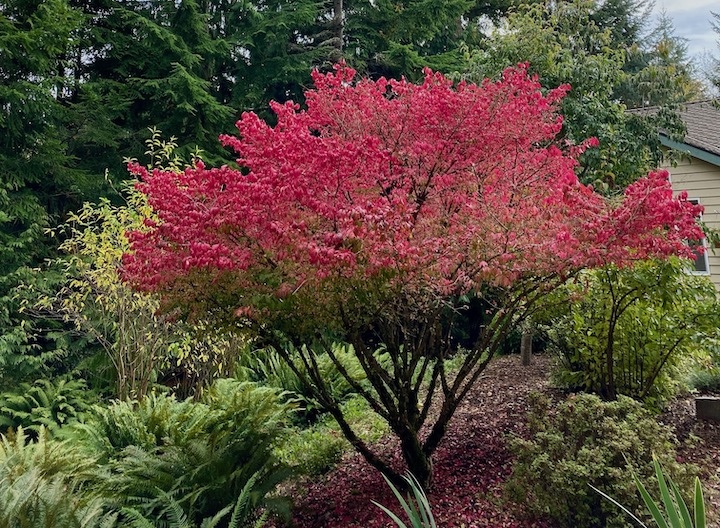by Michele Koomen • Fall is a perfect time to spend some time in your garden thinking about the past growing season
and what plants thrive and what did not. Fall is a time to clean up from summer growth and begin to plan for spring. Here are a few tips to help you begin.
Planning for next season
Take pictures and make notes of your entire garden. Since you will want to rotate vegetables in the next growing season, be sure to jot down or draw out a map where you placed vegetables this year. For herbaceous and perennial plants, take note of which plants worked well and which ones did not and note any bare or open spots that you might want to fill in the next season.
Weed and mulch your garden for success in the spring. After weeding, mulch bare spots. Avoid mulching right up to the tree or shrub trunk (known as volcano mulching). Leave 3-4 inches of space around plant stems and 8-12 inches of open space around trees and large woody plants.
Perennial plant care
Many perennial plants are overwintering homes to insects. “Leave the plant intact and layer leaves or other mulches around the base of the plant while leaving the collar exposed. This will provide good habitat for birds and insects throughout the winter” (WSU Extension). The uncut stalks and stems of plants become great homes for bees and other small insects. For some perennials like hostas, peonies, daylilies, astilbes, bee balm, phlox, peonies, Shasta daisies and Rudbeckias may be cut back to within 2-3 inches of the base so they do not harbor disease (such as powdery mildew) or pests.
You may be interested in collecting some seeds from perennial plants in your garden. Leave a number of seed heads, especially on native plants, intact on the plants in your garden for overwintering birds and wildlife. Collect some perennial seeds such as Echinacea purpurea (purple coneflower; non-native), Rudbeckia occidentalis (western chocolate black-eyed Susan; native), and Delphinium (D. elatum, D. belladonna, D. grandiflorum hybrids; D. nuttallianum native) that are easy to grow perennials from seed. Zinnia, which is an annual, is another great seed to harvest in the fall. Be sure the seed pods are dry before you remove the seed and store them in a dry place. As a way to strengthen regional biodiversity and resilience, the Jefferson County Extension Seed Library offers a selection of locally developed seed to Jefferson County gardeners and seed savers.
Bulbs and tender flowering plants
Dig up tender bulbs like dahlia and store in peat moss, vermiculite or wood shaving where there will be some moisture so they do not completely dry out. Move tender cultivated flowering plants that will not survive low temperatures indoors such as begonias (genus Begonia), bougainvillea (genus Bougainvillea), hibiscus (genus Hibiscus), mandevilla (genus Mandevilla), and most kinds of fuchsia (genus Fuchsia) if you would like to save them for the next season.
To rake or not to rake leaves on your lawn
The Xerces Society reminds us that you can move leaves that are on your lawn and rake them into garden beds, around the base of trees or place them in another designated area. Avoid mowing or shredding leaves on your lawn. Full size leaves that are not mowed or shredded provide habitat to many overwintering insects and birds will forage in them. Instead blow or rake leaves into designated areas of your garden so they remain whole to protect overwintering insects (like butterflies and moths) and their eggs. Finally, plant containers should be cleaned and sanitized with 1-part bleach to 10 parts water before storage.
I wish to acknowledge Barbara Faurot, Jefferson County Master Gardener, for initiating this column in The Leader beginning April of 2020. Her column has been widely praised for sound research based advice to gardeners for the past many years. Michele Koomen will lead the continuation of the column.
Michele Koomen is a Jefferson County Master Gardener working with other volunteers who serve as community educators in gardening and environmental stewardship.
This article first appeared in the Port Townsend Leader November 13, 2024.


